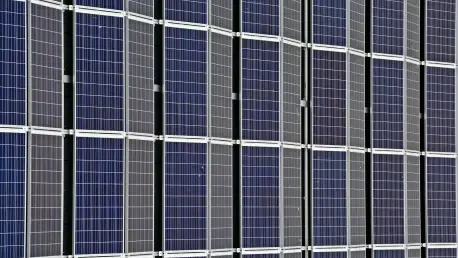In an era where the demand for sustainable energy solutions is at an all-time high, biohybrid solar cells emerge as a groundbreaking innovation poised to reshape industrial energy systems. These remarkable cells combine biological elements with conventional semiconductor materials, striving to enhance efficiency and sustainability in ways that traditional solar panels struggle to achieve. By replicating the natural process of photosynthesis, they utilize proteins such as chlorophyll and photosystem I, sourced from plants, algae, and bacteria, to convert sunlight into electricity. This unique blend of biology and technology offers a promising avenue to tackle persistent challenges in solar energy, paving the way for a more environmentally conscious industrial landscape. As industries grapple with supply chain constraints and carbon reduction mandates, biohybrid solar cells present a potential game-changer, sparking curiosity about how nature-inspired solutions could power the future.
The Promise of Biohybrid Technology
Breaking Efficiency Barriers
Biohybrid solar cells are emerging as a compelling response to the limitations of conventional photovoltaic (PV) systems, particularly in terms of efficiency and material dependency. Traditional solar panels, often reliant on silicon, face efficiency caps and supply chain risks due to the scarcity of critical materials. In contrast, biohybrid cells integrate natural photosynthetic proteins that excel at capturing light and transferring electrons, a process honed by billions of years of evolution. This approach could push efficiency beyond current benchmarks while minimizing reliance on finite resources. According to data from the International Energy Agency, solar PV generation saw a 25% increase in 2023, underscoring the urgency for innovative alternatives as demand surges. Biohybrid technology holds the potential to meet this need, offering industries a path to more robust and efficient energy solutions.
Another key advantage lies in the reduced environmental footprint of biohybrid solar cells compared to traditional systems. By leveraging biological components, these cells decrease the need for mining rare elements like cadmium, which often come with high ecological costs. This shift not only addresses supply chain vulnerabilities but also positions biohybrid technology as a forward-thinking option for industries under pressure to adopt greener practices. The ability to harness sunlight with greater precision through natural mechanisms could redefine performance standards for solar energy. As research continues to refine these cells, the prospect of surpassing conventional PV efficiency limits becomes increasingly tangible, offering a glimpse into a future where industrial energy is both powerful and sustainable.
Sustainability as a Core Advantage
Sustainability stands at the heart of biohybrid solar cell technology, resonating deeply with modern corporate goals to reduce environmental impact. Unlike traditional solar panels that depend on resource-intensive materials, biohybrid cells utilize bio-based components, aligning with the principles of a circular economy. This shift mitigates the risks associated with volatile supply chains for rare materials, providing industries with a more stable energy option. For sectors like chemical manufacturing and construction, adopting such technology signals a commitment to environmental stewardship, a priority increasingly demanded by stakeholders and regulators alike. The potential to lower carbon footprints through renewable energy innovations makes biohybrid cells a strategic asset in meeting global sustainability targets.
Moreover, the environmental benefits of biohybrid solar cells extend beyond material use to their overall lifecycle impact, making them a promising innovation for sustainable energy. These cells are designed to minimize waste and energy consumption during production, further enhancing their eco-friendly appeal. Industries facing stringent carbon reduction mandates can view this technology as a dual-purpose solution—addressing energy needs while advancing sustainability agendas. As market projections suggest significant growth in demand for green energy alternatives, with some estimates pointing to a multi-billion-dollar market by the early 2030s, biohybrid solar cells could become a cornerstone of industrial energy strategies. Their alignment with long-term ecological goals positions them as a vital tool for companies aiming to balance profitability with planetary responsibility.
Applications and Industrial Impact
Versatility for Diverse Needs
The adaptability of biohybrid solar cells sets them apart from traditional solar solutions, opening up a range of niche applications across various industries. Their potential for lightweight, flexible, and even semi-transparent designs makes them ideal for innovative uses such as integration into smart building facades, where they can generate power while maintaining aesthetic appeal. Sectors like logistics and transportation, often operating in remote or mobile environments, could benefit from portable energy solutions powered by these cells. This versatility addresses energy challenges where conventional panels fall short due to size, weight, or design limitations, offering tailored options for industrial needs that are as diverse as the sectors themselves.
Beyond buildings and mobility, biohybrid solar cells show promise in powering industrial wearables and integrated electronics, expanding their utility to specialized equipment. For industries with unique energy demands, such as pharmaceuticals or real estate, these cells provide an opportunity to incorporate renewable power into spaces and devices previously deemed unsuitable for solar technology. The ability to customize energy solutions for specific operational contexts enhances their appeal, potentially transforming how industries approach power consumption. As pilot projects explore these applications further, the practical impact of biohybrid technology on industrial efficiency and innovation becomes clearer, highlighting a future where energy adaptability drives progress.
Tailored Solutions for Niche Markets
Biohybrid solar cells offer tailored solutions that cater to the specific energy requirements of niche industrial markets, setting a new standard for customization. In sectors like construction, where energy needs often intersect with design constraints, semi-transparent panels could be seamlessly embedded into structures without compromising functionality or style. This opens up possibilities for energy-efficient architecture that blends sustainability with modern aesthetics. Meanwhile, industries operating in remote locations, such as mining or agricultural logistics, could leverage the portability of biohybrid cells to power operations far from traditional grids, reducing reliance on costly and polluting diesel generators.
Additionally, the technology’s potential extends to supporting emerging industrial trends, such as the electrification of fleets in transportation. Lightweight biohybrid panels could provide supplementary power for electric vehicles or mobile hubs, enhancing operational range and efficiency in challenging environments. This targeted applicability underscores the technology’s role as a problem-solver for industries with non-standard energy demands. By addressing these specialized needs, biohybrid solar cells not only diversify energy portfolios but also position industries at the forefront of sustainable innovation, ready to adapt to evolving market and regulatory landscapes.
Research and Development Landscape
Driving Innovation Through Collaboration
The development of biohybrid solar cells is propelled by robust collaboration between academic institutions and government initiatives, laying a critical foundation for future advancements in sustainable energy solutions. Universities like Arizona State University are leading the charge with research into photosystem I-based cells, achieving notable efficiency gains in controlled environments. Simultaneously, governmental support in regions like the U.S. and Europe fuels progress, with the U.S. Department of Energy investing over $45 million in solar technologies in recent years. Programs such as Europe’s Horizon 2020 further prioritize next-generation energy solutions, fostering an ecosystem where laboratory breakthroughs can evolve into practical applications. These efforts signal a strong commitment to pushing biohybrid technology forward.
Equally significant is the role of international partnerships in accelerating research timelines and sharing expertise across borders, fostering a collaborative environment for innovation. Collaborative projects under frameworks like the European Green Deal bring together scientists, engineers, and policymakers to address technical challenges collectively. This synergy not only enhances the pace of innovation but also ensures that developments are aligned with global energy goals. For industrial stakeholders, these collaborative endeavors provide early insights into emerging technologies, offering opportunities to engage with research hubs. As proof-of-concept milestones accumulate, the path from experimental labs to real-world testing becomes increasingly viable, promising a transformative impact on industrial energy systems.
Building a Foundation for Scalability
Beyond initial research, the focus on scalability remains a pivotal aspect of biohybrid solar cell development, ensuring that laboratory successes translate into market-ready solutions. Current efforts are centered on refining the integration of biological components with semiconductors to withstand industrial-scale production demands. Research teams are exploring advanced manufacturing techniques that could lower costs while maintaining the integrity of delicate photosynthetic proteins. This step is crucial for bridging the gap between small-scale experiments and widespread deployment, a challenge that requires both technical ingenuity and strategic investment from public and private sectors alike.
Furthermore, pilot projects are emerging as a testing ground to evaluate the real-world performance of biohybrid solar cells under diverse conditions. These initiatives, often backed by government funding, aim to identify practical hurdles and optimize designs for durability and efficiency. The data gathered from such trials will inform future iterations, guiding industries on how to integrate this technology effectively. As scalability challenges are addressed, the confidence of industrial adopters grows, fostering a gradual shift toward incorporating biohybrid solutions into broader energy strategies. This foundation-building phase, though complex, is essential for realizing the full potential of biohybrid solar technology in the industrial realm.
Challenges on the Horizon
Technical and Economic Hurdles
Despite their promise, biohybrid solar cells face significant technical challenges that must be overcome before they can achieve widespread industrial adoption. The biological components at the core of these cells, such as photosynthetic proteins, are inherently fragile and susceptible to degradation when exposed to harsh environmental factors like heat, oxygen, and UV radiation. Researchers are actively developing encapsulation techniques to shield these materials, but such solutions add layers of complexity to the manufacturing process. Until stability is assured under real-world conditions, the reliability of biohybrid cells for long-term industrial use remains in question, posing a barrier to their integration into mainstream energy systems.
Economic obstacles further complicate the journey to commercialization, with high production costs standing as a primary concern. Extracting and stabilizing biological molecules is a resource-intensive process, driving up expenses compared to conventional solar technologies. Additionally, the supply chain for bio-based materials is underdeveloped, lacking the infrastructure needed for large-scale production. Regulatory uncertainties surrounding bioengineered energy components also create hesitation among potential adopters. For industries accustomed to predictable costs and established supply networks, these economic and systemic challenges highlight the need for sustained investment and innovation to make biohybrid solar cells a viable option.
Navigating Regulatory and Systemic Barriers
Beyond technical and economic issues, regulatory and systemic barriers present another layer of complexity for biohybrid solar cell deployment. The integration of bioengineered materials into energy systems raises questions about safety, environmental impact, and compliance with existing standards, many of which were designed for traditional technologies. Policymakers are still in the process of crafting frameworks that address these unique considerations, leaving industries in a state of uncertainty about future requirements. This lack of clarity can delay investment decisions, as companies weigh the risks of adopting a technology that may face evolving or inconsistent regulations across regions.
Moreover, systemic challenges, such as the need for specialized training and infrastructure to support biohybrid technology, add to the adoption hurdles. Industrial sectors must prepare for shifts in workforce skills and operational processes to accommodate this innovation, a transition that demands significant time and resources. Collaboration between governments, research bodies, and industry leaders is essential to streamline regulatory pathways and build the necessary support systems. Addressing these barriers will be critical to ensuring that biohybrid solar cells move beyond experimental stages and into practical, large-scale industrial applications, fulfilling their potential as a sustainable energy solution.
Future Outlook and Strategic Implications
Timeline for Deployment
Looking ahead, the timeline for biohybrid solar cell deployment points to a gradual but promising progression from laboratory research to pilot-scale projects over the next decade. Experts draw comparisons with the rapid rise of perovskite solar cells, suggesting that once key technical and cost barriers are addressed, adoption could gain momentum swiftly. This projection, spanning from now to the early 2030s, underscores the importance of sustained research and development efforts to refine the technology. For industrial leaders, this timeline serves as a call to monitor advancements closely, preparing for integration as pilot initiatives demonstrate real-world feasibility and reliability.
Additionally, the decade-long horizon offers a strategic window for industries to position themselves as early adopters of biohybrid technology. Engaging with research institutions and participating in pilot programs could provide a competitive edge, allowing companies to influence the direction of development and tailor solutions to their specific needs. The gradual nature of this rollout also mitigates risks, giving industries time to adapt existing energy frameworks. As breakthroughs emerge, the transition from experimental to operational use will likely accelerate, making proactive involvement a key factor in capitalizing on the transformative potential of biohybrid solar cells.
Complementary Role in Energy Systems
Biohybrid solar cells are not positioned to replace silicon-based PV systems outright but rather to complement them, enhancing overall solar energy strategies with their unique strengths. Their ability to achieve higher efficiency through natural light-capture mechanisms and operate in niche applications makes them an ideal supplementary technology. This complementary role allows industries to diversify energy portfolios, combining the reliability of traditional panels with the innovative benefits of biohybrid designs. Such a hybrid approach could optimize energy output while addressing specific limitations of conventional systems in varied industrial contexts.
Furthermore, the integration of biohybrid solar cells into existing energy frameworks fosters resilience against supply chain disruptions and material shortages that often plague traditional solar technologies. By offering an alternative that reduces dependence on scarce resources, these cells contribute to a more balanced and sustainable energy mix. This perspective is widely shared among academic researchers, industry stakeholders, and policymakers, who view biohybrid technology as a vital piece of the renewable energy puzzle. As development progresses, its role in bolstering industrial energy systems will likely become more defined, providing a flexible tool for meeting diverse power demands.
Policy as a Catalyst
Policy support plays a pivotal role in accelerating the adoption of biohybrid solar cells, with initiatives in the U.S. and Europe setting a strong precedent for innovation. The U.S. Department of Energy’s substantial investments in solar advancements, combined with Europe’s commitment through frameworks like the European Green Deal, create a favorable environment for research and deployment. These policies not only provide critical funding but also signal to industries that biohybrid technology aligns with broader renewable energy objectives. Such institutional backing reduces perceived risks for companies considering early adoption, encouraging investment in sustainable solutions.
In addition, policy frameworks are increasingly focused on reducing reliance on scarce materials, a goal that aligns closely with the sustainability advantages of biohybrid solar cells. Incentives and grants under programs like Horizon 2020 in Europe further encourage collaboration between public and private sectors, driving the technology toward market readiness. For industrial stakeholders, this policy landscape offers a clear directive to integrate next-generation solar solutions into long-term energy plans. As governmental support continues to evolve, it will likely accelerate the transition of biohybrid cells from experimental concepts to practical tools, shaping the future of industrial energy production.
A Vision for Industrial Energy
Reflecting on the journey of biohybrid solar cells, their development marked a significant chapter in the quest for sustainable industrial energy solutions, showcasing a remarkable fusion of nature’s brilliance with human engineering. This technology stood as a testament to innovation aimed at addressing efficiency and environmental challenges. In labs across the globe, researchers tirelessly worked to stabilize biological components, while policymakers crafted supportive frameworks to guide adoption. Industries watched closely as pilot projects unfolded, revealing both the promise and the hurdles of integrating these cells into real-world applications, setting the stage for a gradual transformation in how energy was harnessed.
Looking back, the collaborative efforts among academia, government, and industry proved instrumental in navigating the complexities of biohybrid technology, paving the way for significant advancements. The next steps involved a focused push toward overcoming remaining technical barriers and scaling production through strategic partnerships. Industries were encouraged to invest in pilot initiatives and align energy strategies with emerging advancements, ensuring readiness for broader deployment. As a beacon of sustainable innovation, biohybrid solar cells offered a pathway to redefine industrial power systems, blending efficiency with ecological responsibility for a resilient energy future.









